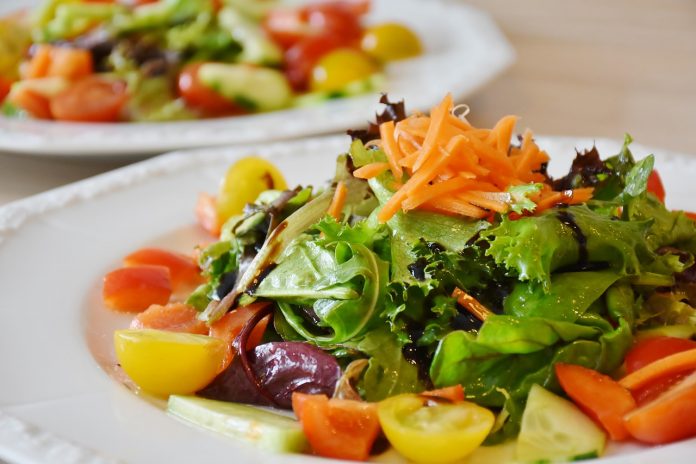
If someone in your house is trying to lose weight, there are several things you can do to help. These suggestions are called behavior modification techniques because the suggestions focus on the eating behavior, not the food. Be supportive of the dieter and point out their successes. Don’t nag, threaten, bribe or try to force the dieter to stick to the diet. It is a negative reinforcement which causes the dieter more guilt and shame. Also, they tend to eat more in secret. No one likes to feel bad about her or himself.
Clean up your home food environment. Don’t wait to eat up what you already have in your house, give it away or throw it away. Get rid of sweets and salty snacks. If you don’t buy it or bake it, food has a hard time finding its way into your mouth.
Go along with eliminating salted snack foods, sweets, and desserts from your house and shopping lists. Don’t be selfish and insist you still want the dieter to bake for you. Praise the dieter for cooking lower calorie meals.
When a dieter starts losing weight, other members of a household can become threatened by the dieter’s new body image. This is especially true because the dieter becomes more attractive as weight is lost. At this point, the non-dieter will start offering sweets to the dieter. This is subversive to the dieter by sending two messages. “I think you should lose weight, but not too much because I am threatened with losing you.” The dieter is confused about the double message and will often feel anger toward the non-dieter. This should be talked out between dieter and non-dieter and resolved to a supportive food atmosphere.
If the dieter finds that some habits are hard to change, such as vending machine or coffee break habits, a change of route to avoid going by the vending machine should help. Bring an alternative snack for coffee breaks. Physically avoid the kitchen when your appetite tells you to eat, but you are not hungry.
When tired, stressed, bored, angry, lonely or frustrated, choose an alternative to eating. Ahead of time, make a list of things you enjoy or would like to do. Don’t choose something you don’t like. When your mood shifts to eating, choose one alternative activity instead of eating.
Try to assess your degree of hunger. Ask yourself, are you hungry or are you eating for other reasons? Hunger symptoms include a growly, empty feeling in your stomach. Other symptoms are your blood sugar may be low and you may feel weak and shaky. If you assess that you are hungry, eat until you feel the sensation of fullness and then stop eating. If you are eating for other reasons, try doing something else for 10 minutes. Physically remove yourself from the sight or smell of food. Later, you will find that you forgot to eat.
Train yourself to sense what full feels like. A lot of overweight persons eat right over the feeling of fullness because they are eating so fast or have waited until they are over hungry to eat. The sensation of fullness is when you may stop or pause eating. Your stomach feels full, almost like you need to burp. When you feel like this, stop eating, push your plate away or ask to have your plate removed and walk away from the table.
Eat more slowly. Breakfast should take about 20 minutes, lunch and supper 30 to 40 minutes to eat. It takes 20 minutes for a message to get from your stomach to your brain that you are full. If you eat fast, you can easily overeat in 20 minutes.
Research has proven that if you eat soup as the first course to a meal, you will eat fewer calories at that meal. Choose broth-based soups because they are lower in fat and calories than cream based soups.
Sit down at the table whenever you eat. Don’t eat standing in front of the stove, refrigerator or sink. If you don’t have enough time to sit down at a table with a plate, knife, and fork, you don’t have enough time to eat. Also, don’t eat while watching television.
Chew slowly. Savor your food and put your fork down between bites. The first phase of digestion starts with the chewing and mixing with saliva in your mouth. You are more likely to choke on a large piece of food that is swallowed without enough chewing. Some of the satisfaction from eating is achieved by chewing food longer.
Drink liquids, preferably water or skim milk, between forkfuls of food. Stop eating to talk with others at the table. Mealtimes are a good opportunity to socialize.
Train yourself to leave food on your plate. This is probably the hardest for people who grew up in the clean-your-plate club. To change that eating habit, you should start by leaving food on your plate. Notice how normal weight persons usually leave food. When you feel good about leaving food on your plate, start reducing the size of your portion. The end result should be that you serve yourself smaller portions and stop eating when you are full, no matter how much food is left on your plate.
Be the last person at the table to finish eating. Pace yourself during a meal to eat more slowly. If you notice that you are ahead, put down your fork and wait for others to catch up. Eat as slow as the slowest person does at the table.
Most overweight persons fill their plates full. If you have found it difficult to limit your food portions, use a smaller plate. A seven-inch salad plate will help you limit your food intake. If you still feel the urge to “fill your plate”, a smaller plate won’t hold as much.
The same idea works with beverage glasses. Choose a smaller glass for beverages and fill it just once. Maybe you don’t know how many ounces fill your favorite glass. Fill your favorite beverage glass to the level you usually do. Pour the water from your beverage glass into a large glass measuring cup. Look at the ounce measure on the side of the measuring cup. This will tell you how many ounces fill your beverage glass. Eight ounces is one cup. To limit calorie-containing beverages, use an eight-ounce glass for beverages and fill the glass just once.
Decide what you are going to eat before you go out so that you are not influenced by what others order or what you see. When served your main entree, cut your portion size and move the rest of the food to the side of your plate. If you don’t know what an appropriate portion size is, look at the back of your hand. A piece of meat that would stretch from where your wrist bends up to your knuckles at the base of your fingers and as thick as your little finger is wide, would be three to four ounces depending on the size of your hand. When you are finished with your portion, ask the waiter/waitress to remove your plate so that you will not restart eating. Also, when eating at buffets or private homes, limit yourself to one serving. Take an appropriate first serving and eliminate additional servings.
Go grocery shopping after you’ve eaten a meal. Bring a shopping list and stick to it. Don’t walk down aisles with carbonated beverages, chips or candy in them. Don’t buy anything unless it is on your list and don’t put salty snacks or sweets on your list.
Food manufacturers and grocers know where to place food on shelves for the best sales volume. For instance, take a look at the positioning of cold cereals in your local grocery store. The high sugar cereals are on the lower and middle shelves. This is just about the right height for a toddler in a cart or child. The high fiber cereals are on the top shelves for adult’s best viewpoint. Also, food displays at the end of aisles and at the check out counter are not placed there for your convenience because you may have forgotten to pick up that very food in another aisle. Food displays are put there because they are higher trafficked areas in the store. You are a captive shopper when waiting in the check out lines. Where are the basic foods like fruits and vegetables, meats, bread and dairy products placed in most grocery stores? Usually, these foods line the outside aisles and back of the store. This physically drags you through the store, distracts you and entices you to make impulsive purchases.
When visiting a food pusher’s house say no to inappropriate food or beverages and stick to it. Don’t get drawn into the argument that you should have just a small piece or that you have insulted their hospitality. If you have to offer a reason, tell them that you are on a special diet or are allergic to the food.
If you blow your diet by eating an inappropriate food, acknowledge it and get on with your diet plan. Don’t hit yourself over the head with guilt and shame. Say to yourself, “OK, I ate it, but that is not more important than the efforts I have made so far.” Immediately no matter what day of the week or hour it is, resume your diet plan. Don’t dwell on negative experiences.
Eating habits are formed, not inherited from your parents. They can be changed through practice. The more often you repeat a new habit, the more likely, it is going to replace your old habit. New habits also become easier with time.


